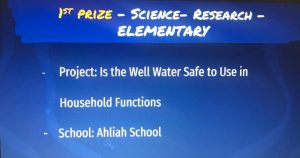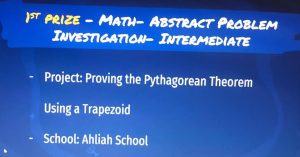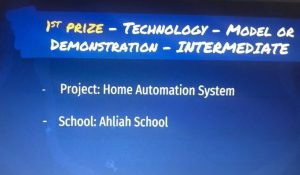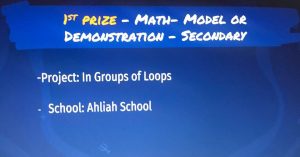
Congratulations to Ahliah students on their amazing achievement at the AUB Science and Math Fair 2023. Ahliah participated in six projects from the lower school, middle, and upper school divisions. Four out of six won the first prize in the different categories. The Ahliah-winning projects are:
First Prize Science- Research, Lower School
Is the Well Water Safe to Use in Household Functions? Mariam Naim, Mohammad Kolailat, Layal Kanounji, and Adam Mashmousi investigated the safety of Beirut well water for household use. Their question arises from the problem of shortage of water supply by the municipalities in Lebanon and people are resorting to well-water supply. They researched how well water is extracted, what happens with the over-extraction of well water, and what could be sources of contamination. Then, they collected samples from different wells in different areas in Beirut and tested their PH, total dissolved substances, and bacterial contamination.

First Prize Math- Abstract Problem Investigation, Middle School
Grade 8 Ahliah students Lynn Asso, Mariam Tawil, Karim Khatib, and Youssef Saad worked on Proving the Pythagorean Theorem Using a Trapezoid. Commonly, the Pythagorean theorem is proved using squares, where the sum of areas of squares made using both legs of a right triangle is demonstrated to be equal to the area of the square made using the hypotenuse. After studying special parallelograms and trapezoids, grade 8 students wondered if the Pythagorean theorem can be proved differently, and worked on a well-constructed and elegant proof using a trapezoid. Their interest in the Pythagorean theorem arise from the challenge to install a zipline for the summer camp at school and the importance of calculating the length of that line which can be done through the Pythagorean theorem.

First Prize Technology, Middle School
Home Automation System Project by Mostafa Tannir.
In this project, we built a prototype of a home automation system using Arduino that allows for the control and automation of various devices and appliances within a home. With the use of sensors, actuators, and programming, the Arduino board is programmed to perform specific tasks such as turning ON/OFF lights, air conditioners, refrigerators etc… This system can be controlled remotely through a smartphone app, allowing for easy access and control from anywhere. The flexibility and versatility of the Arduino platform make it a popular choice for home automation projects, as it can be easily integrated with a wide range of devices and appliances. Additionally, the open-source nature of Arduino allows for a community of users to share and build upon each other’s work, resulting in a constantly evolving and improving system.
We benefited from this project to monitor the different sources of electricity to the home like the government electricity, the solar panel, or the building’s electric generator. The electricity in the home will thus be used efficiently to minimize the monthly bill.

First Prize Math- Model or Demonstration, Upper School
In Groups of Loops is the project which Adam Makmouk, Rana Tadmori, Rena Masri, and Zara Zakkar worked on and presented. In order to promote collaboration among students, Grade 11 decided to challenge their classmates with a game that seemed impossible” at first. They gathered 10 students in a room and numbered them from 1-10. Slips of paper with their numbers are randomly placed in 10 boxes. Each student may enter the room one at a time and check any 5 of the boxes searching for his/her number. They must leave the room exactly as they found it and can’t communicate with the others after. If all 10 students find their own numbers during their turn in, they will all win. However, If 1 student fails, they would all lose, and that condition will arouse their desire to succeed all together & not work solely. The students are allowed to strategize before entering the room. In their first experiment, the players chose the numbers from the boxes randomly and the probability of success was extremely low. Then, our students worked on a strategy to improve the success rate from around 0% to 31%. Their method is based on the loop strategy which works on following a closed loop of numbers. Students experimented again and they were able to notice a huge impact on the success rate. Not only that, but they generalized their findings and they proved that the loop strategy works with any number of players.

We are proud of you All.